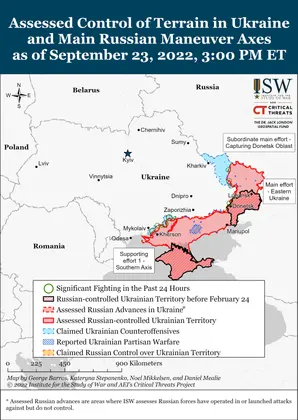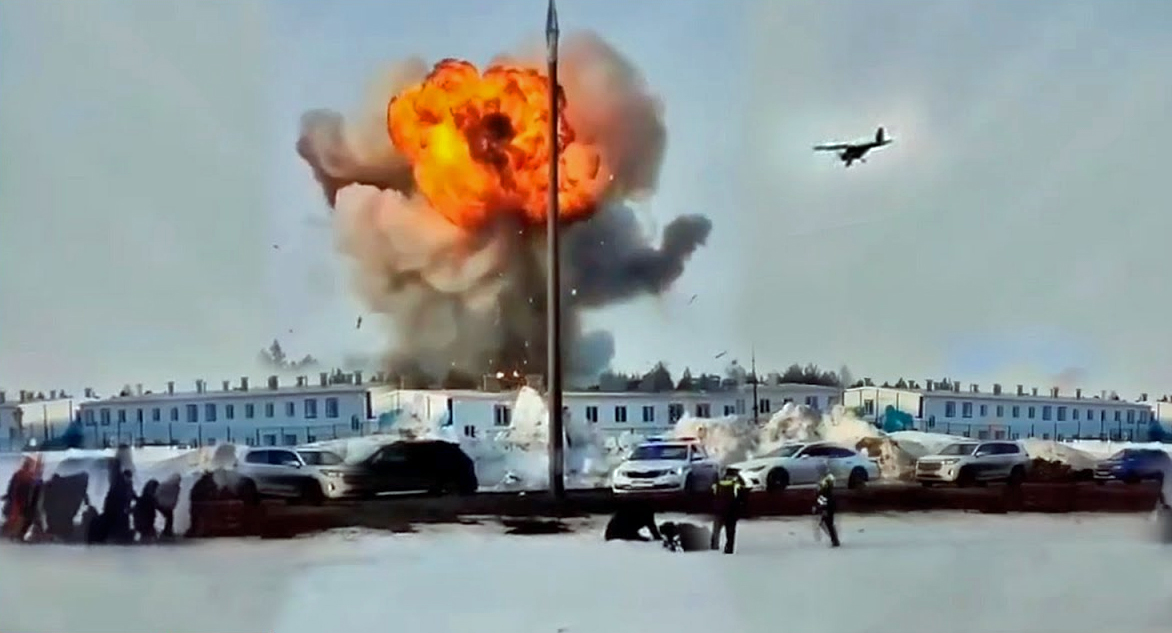Key Takeaways
- Russian partial mobilization efforts are suffering from serious and systemic problems in their first days, generating popular resentment and setting conditions to produce a mobilized reserve force incapable of accomplishing the tasks Russian President Vladimir Putin has set for it.
- Protests, attacks against recruiting centers, and vandalism have occurred across Russia in the first 48 hours after the announcement of partial mobilization.
- Ukrainian forces continued to advance north and northwest of Lyman.
- Ukrainian forces continued their interdiction campaign in Kherson Oblast and maintained operational silence regarding Ukrainian progress on the axis.
- Russian forces continued to launch unsuccessful assaults near Bakhmut and northwest of Donetsk City.
- Ukrainian forces reportedly shot down an Iranian-made Mohajer-6 drone in an unspecified area of the Black Sea, likely near Odesa.
- Russian occupation authorities began the voting period for their sham annexation referenda on September 23 with overt coercion and falsified turnout numbers.
- Russian occupation authorities remained on high alert to prevent partisan attacks against sham election workers, polling stations, and government facilities.
The Russian mobilization system is struggling to execute the task Russian President Vladimir Putin set and will likely fail to produce mobilized reserve forces even of the low quality that Putin’s plans would have generated unless the Kremlin can rapidly fix fundamental and systemic problems. Putin and Defense Minister Sergey Shoigu announced that the Russian Armed Forces would mobilize combat-ready reservists to quickly stabilize the frontlines and regain the initiative on the battlefield.[1] Milblogger and social media reports, however, show that Russian military recruitment centers, enlistment officials, and local administrations are mobilizing men who do not meet the Kremlin’s stated criteria, especially Shoigu’s promise that mobilization would prioritize men with “combat experience.” Russian opposition outlets and Telegram channels leaked information suggesting that the Kremlin aims to complete this partial mobilization by November 10 and that the Kremlin is seeking to mobilize 1.2 million men instead of the publicly announced 300,000.[2] ISW cannot verify these reports, but significant available information suggests that this mobilization campaign (the first in post-Soviet Russia) is overwhelming an ineffective and unmotivated bureaucratic system and could fail to generate the much-needed combat-ready reserve force in a short time or at all.
JOIN US ON TELEGRAM
Follow our coverage of the war on the @Kyivpost_official.

ISW Russian Offensive Campaign Assessment, December 24, 2024
Russian pro-war milbloggers and social media users are raising concerns about unlawful mobilization practices and showcasing many serious Russian mobilization problems on the second day of the mobilization effort. Russian milbloggers reported receiving numerous complaints from social media users that older men, students, employees of military industries, and civilians with no prior military experience are receiving illegal mobilization notices.[3] Shoigu and other officials have repeatedly stated that these categories of individuals would be exempt from this partial mobilization. Other sources reported that Russians are mobilizing airport and airline employees and workers from other industries.[4] The Russian government FAQ portal also indicated that local mobilization-enforcing officials may mobilize part-time students, despite the Kremlin’s declaration that no students will undergo mobilization.[5]
Challenges and errors in the first days of executing a large-scale and demanding partial mobilization in the midst of a failing war are not necessarily surprising, although they suggest that the Russian military mobilization infrastructure was not better prepared for a major war than the Russian armed forces themselves. It is nevertheless conceivable that the Russian Ministry of Defense will address some of the worst problems and get the mobilization effort on track. It is also possible, moreover, that much of the partial mobilization is proceeding more or less as planned and that social media and the milblogger community are highlighting problems that are serious but not necessarily pervasive. Some of the reports suggest, however, that regional mobilization officials have been given quotas to fill and received pressure to fill them in ways that are more likely to cause errors than to reward adherence to the stated principles and the needs of an effective, combat-ready reserve force.
Divergences from the mobilization decree and from Putin’s and Shoigu’s statements about the categories of men who are exempt from mobilization are also causing anger and mistrust toward Russian federal subjects and the Kremlin itself. Some social media footage already shows mobilized men fighting with enlistment officers, arguing with mobilization representatives, and refusing to serve under unlawful orders.[8] Some milbloggers claimed that some of the discontented men who have been wrongfully mobilized would have accepted their fate if they had actually met the mobilization criterium.[9] The Kremlin is thus committing unmotivated and potentially angry men to war with the task of regaining the initiative in an offensive war in a foreign land on a battlefield far from home.
The highly nationalist and pro-war milblogger community is calling on the Kremlin to address these mobilization issues rapidly, but the Kremlin is unlikely to be able to meet their demands. Russian milbloggers express cautious optimism that partial mobilization will reinforce degraded combat units and allow Russian forces to advance in Donetsk Oblast, but are concerned that the Kremlin’s failures to enforce mobilization according to the law and stated policies will create political unrest.[10] One milblogger stated that the Kremlin’s poor handling of the partial mobilization is giving rise to “separatist movements” and opposition media.[11] Another milblogger noted that the Kremlin’s failure to fix mobilization practices within the military recruitment centers may shatter Russians‘ trust in the military-political leadership.[12] A failed or badly flawed partial mobilization campaign may risk further alienation of the Russian nationalist crowd that has been supportive of the war and mobilization.
Disparate mobilization processes across different regions may exacerbate social tensions in Russia already raised by perceived inequalities in the creation of volunteer battalions. Chechen leader Ramzan Kadyrov stated in a live TV broadcast that the Republic of Chechnya will not conduct mobilization because the Republic has already exceeded an unspecified force generation plan by 254 percent.[13] Kadyrov added that Chechnya has already deployed 20,000 servicemen to war since February 24. Kadyrov threatened to mobilize any protesters in Chechnya and send them to the front, however. Kadyrov then seemingly modified his statements by encouraging those opposing mobilization to respect Russian sovereignty instead of using the constitution to avoid service.[14] Kadyrov’s initial statement, addressed to the Chechen public, may be an attempt to both address and discourage criticism of mobilization, the war, and himself within the Chechen community. Kadyrov’s statement could also be a worrisome indicator for the Kremlin—if one of the war’s most vociferous and aggressive advocates feels the need to refuse to mobilize his people, at least publicly, that could indicate that even Kadyrov senses the popular resentment the partial mobilization will cause and possibly even fears it.
See the full report here.
You can also highlight the text and press Ctrl + Enter






